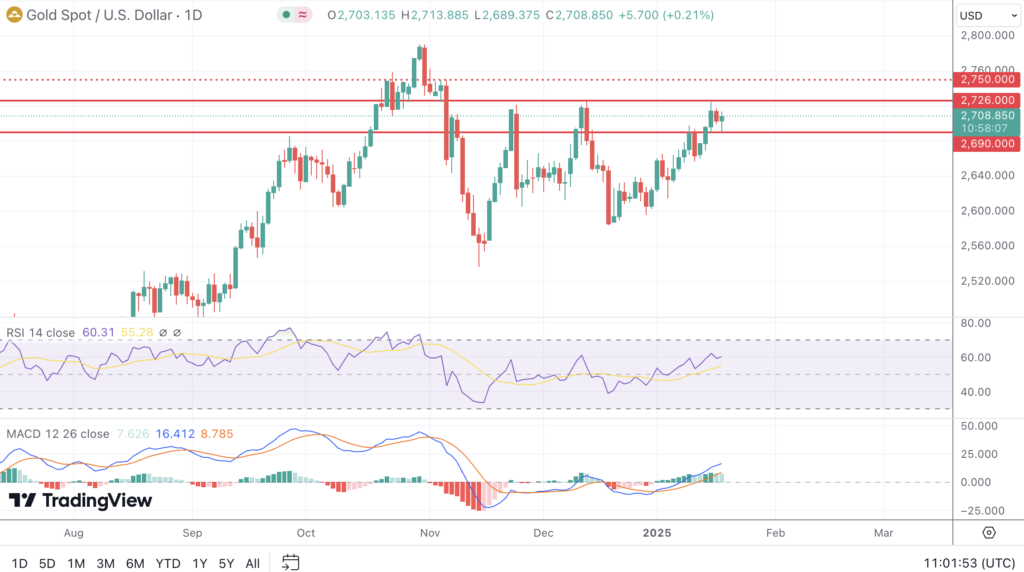Key Takeaways:
- Gold is currently holding support around $2,690, with key resistance at $2,726. A break above this level could push prices toward $2,750 and $2,790.
- The 10-year Treasury yield decline has supported gold, but the U.S. dollar remains a limiting factor for further upside.
- Inflation expectations and Federal Reserve policy remain central to gold’s movement, with traders watching for signals of potential rate cuts.
- Trump’s economic policies, particularly trade tariffs and fiscal stimulus, could have a significant impact on inflation and the Fed’s policy direction, influencing gold prices.
Market Dynamics and Recent Performance
Gold (XAU/USD) remained relatively steady, trading around $2,703 as traders positioned themselves ahead of Donald Trump’s inauguration. The upcoming policy shifts, particularly in trade and fiscal policies, have added uncertainty to market sentiment, reinforcing gold’s safe-haven appeal. Last week’s price action was influenced by easing U.S. inflation data, which strengthened expectations of a dovish Federal Reserve stance. However, a stronger U.S. dollar and stable Treasury yields have kept gold from breaking higher.
Trump’s potential economic measures, including proposed tariffs and infrastructure spending, are expected to have inflationary effects. If these policies materialize, they could challenge the Federal Reserve’s current monetary policy outlook. Gold’s recent stability reflects the market’s cautious stance as traders await further clarity on these developments.
Technical and Fundamental Influences
Gold’s technical structure remains constructive, with key support around $2,690 and resistance at $2,726. A break above the $2,726 level could open the door for further upside toward $2,750 and possibly $2,790. Momentum indicators like the RSI suggest that gold is trading in a neutral zone, neither overbought nor oversold. The MACD signals a potential bullish crossover, though the strength of the move remains uncertain.

From a fundamental perspective, falling Treasury yields have provided support to gold, with the 10-year yield dropping by 13 basis points last week. This decline reduces the opportunity cost of holding gold, making it more attractive for investors. Meanwhile, the latest Consumer Price Index (CPI) report showed a 0.2% monthly increase, reinforcing expectations that inflation is cooling. If inflation remains subdued, the Fed may be more inclined to cut rates, which could be bullish for gold.
Trump’s policy agenda introduces a new layer of uncertainty. Potential tariffs on imports could drive inflation higher, complicating the Fed’s ability to cut rates. Additionally, any fiscal stimulus measures, such as infrastructure spending and tax cuts, could lead to a larger deficit, which historically supports higher gold prices as a hedge against economic instability.
Looking Forward
The upcoming week will be critical as markets react to Trump’s inauguration and any initial policy statements. If his administration signals aggressive fiscal stimulus or new tariffs, inflation expectations could rise, supporting gold prices. However, if the Federal Reserve maintains a cautious stance, waiting for more economic clarity before adjusting interest rates, gold could remain range-bound.
Investors will also focus on additional U.S. economic data, including jobless claims and housing market reports. Stronger-than-expected data could pressure gold by reinforcing the strength of the U.S. economy, while weaker data could provide further support for the metal.

